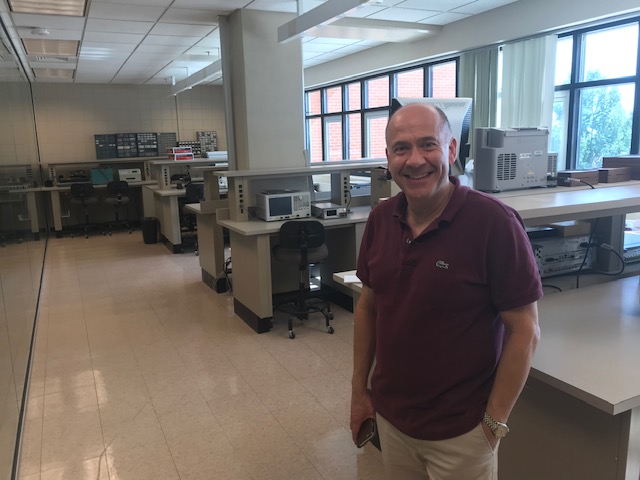Tornadoes, earthquakes and even the occasional inland hurricane or derecho, as it was called. All are foreseeable events that could take down portions of the communication grid when it’s needed most.
Researchers at Southern Illinois University Carbondale soon will embark on an effort not only to fortify the local communications infrastructure, but also to investigate how green energy might be used to power it.
Large grant funds research
Working with a $900,000 grant from the Illinois Environmental Protection Agency and U.S. Department of Energy, SIU’s Engineering Building will soon be a proving ground for new, sustainable ideas for back-up power and communications.
The grant will help campus faculty, students and others design and install solar power panels, along with power storage facilities, on the roof of Engineering D building. It also will pay for additional cell phone-internet communication infrastructure, as well as the high-tech switching and monitoring equipment needed to control the network.
The project, when finished, is aimed at sustaining emergency computing and communications in the event of a disaster rendering normal power systems and wireless networks inoperable.

Project could be model for all state universities
Researchers and state officials hope the system will serve as a model for self-sustaining buildings and communication infrastructure that will remain available in a disaster said Spyros Tragoudas, professor and chair of the electrical and computer engineering degree program and principal investigator on the grant.
“Using the grant, we will develop a state-of-the-art infrastructure on campus based on renewable energy,” Tragoudas said.
The SIU Board of Trustees approved the project in May, as it impacts campus facilities. The grant received final approval earlier this year.
Work is under way
Tragoudas said work is beginning soon, with its completion scheduled for June 2020. He leads a team of SIU engineering researchers including: Constantine Hatziadoniu (energy and power), Haibo Wang (sensor and electronics), Iraklis Anagnostopoulos (embedded systems software), Arash Komaee (controls) and Aruma Baduge (wireless communications).
Solar power panels will be installed on the roof of Engineering Building D sometime during the next few months. The project also will see the installation of several cell phone pods that would fortify the local network in time of emergency or damage event. Researchers and students will control the array and supplemental power from a new state-of-the-art control room inside the Engineering Building E.
The solar panels will have a 105kW generation capacity as well as large amount of storage capacity. In the events of power outage, it will sustain the operation of a computing and control room in Engineering Building E, as well as a wireless communication infrastructure.
“The effort will provide with a model for self-sustainable buildings and communication infrastructure that will remain operational in case of a disaster that impacts landline and tower-based wireless networks,” Tragoudas said. “The IEPA sees this as a pilot project that could serve as a model for all state universities.”
Data to provide answers
Researchers will use the infrastructure and data obtained from the system’s operations to demonstrate whether solar power and energy storage can provide a viable alternative to traditional diesel-powered generators in such applications.
In addition, the project will develop solar powered LTE communication modules to sustain cellular communication for emergency responders in the events of natural disasters that cause outages of both power and cellular services.







